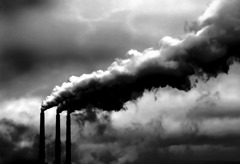Worldwide levels of the chief greenhouse gas that causes global warming have hit a milestone, reaching an amount never before encountered by humans. Carbon dioxide was measured at 400 parts per million at the oldest monitoring station in Hawaii which sets the global benchmark. According to the National Oceanic and Atmospheric Administration, the last time the worldwide carbon level was probably that high was about 2 million years ago. That was during the Pleistocene Era. Other scientists say it may have been 10 million years ago that Earth last encountered this much carbon dioxide in the atmosphere.  The first modern humans only appeared in Africa about 200,000 years ago. The measurement that was recorded is only a daily figure, the monthly and yearly average will be smaller. The number 400 has been anticipated by climate scientists and environmental activists for years as a notable indicator, in part because it's a round number — not because any changes in man-made global warming happen by reaching it. Physically, we are no worse off at 400 ppm than we were at 399 ppm. But as a symbol of the painfully slow pace of measures to avoid a dangerous level of warming, it's somewhat unnerving. "This number is a reminder that for the last 150 years — and especially over the last several decades — we have been recklessly polluting the protective sheath of atmosphere that surrounds the Earth and protects the conditions that have fostered the flourishing of our civilization. We are altering the composition of our atmosphere at an unprecedented rate", said Al Gore. Carbon dioxide traps heat just like in a greenhouse and most of it stays in the air for a century; some lasts for thousands of years. It accounts for three-quarters of the planet's heat-trapping gases. There are others, such as methane, which has a shorter life span but traps heat more effectively. Methane concentrations also are rising because of human activity such as industrial farming.
The first modern humans only appeared in Africa about 200,000 years ago. The measurement that was recorded is only a daily figure, the monthly and yearly average will be smaller. The number 400 has been anticipated by climate scientists and environmental activists for years as a notable indicator, in part because it's a round number — not because any changes in man-made global warming happen by reaching it. Physically, we are no worse off at 400 ppm than we were at 399 ppm. But as a symbol of the painfully slow pace of measures to avoid a dangerous level of warming, it's somewhat unnerving. "This number is a reminder that for the last 150 years — and especially over the last several decades — we have been recklessly polluting the protective sheath of atmosphere that surrounds the Earth and protects the conditions that have fostered the flourishing of our civilization. We are altering the composition of our atmosphere at an unprecedented rate", said Al Gore. Carbon dioxide traps heat just like in a greenhouse and most of it stays in the air for a century; some lasts for thousands of years. It accounts for three-quarters of the planet's heat-trapping gases. There are others, such as methane, which has a shorter life span but traps heat more effectively. Methane concentrations also are rising because of human activity such as industrial farming. 
May 11, 2013
Subscribe to:
Post Comments (Atom)


No comments:
Post a Comment